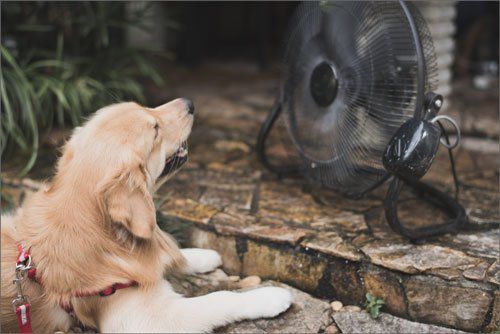Blog Post

Protect Your Dog From Heatstroke This Summer
- By
- •
- 03 Aug, 2018

Heatstroke poses a real threat to your furry buddy. As the mercury rises outside, so does your dog's internal temperature, which means having them outside too much in that heat can cause health problems.
You need to keep a close eye on your dog during the hot summer days and watch out for signs of heatstroke. If you aren't sure what to look for, read on for symptoms of heatstroke and what you can do to protect your dog this summer.
You need to keep a close eye on your dog during the hot summer days and watch out for signs of heatstroke. If you aren't sure what to look for, read on for symptoms of heatstroke and what you can do to protect your dog this summer.
Signs of Heatstroke
Some signs to pay attention to this summer include:
- Excessive drooling. If your dog isn't typically a drooler and suddenly they are drooling quite a bit, they could have heatstroke. Get your dog to a cool and shady place, and then try to give them small amounts of water.
- Fatigue. If your dog shows signs of fatigue or lameness, such as not getting up to greet you, sleeping quite a bit, or not wanting to play as they normally would, it could be due to heatstroke.
- Excessive panting or rapid heartbeat. If your dog is panting heavily or having a hard time catching their breath, they may have heatstroke. Encourage your dog to lie down in a cool space, and place a cool towel on the back of their neck and behind their front legs.
Other signs include weakness or collapse, vomiting, or even lack of appetite. If you've spotted any of these signs, get your dog help right away.
Treatment of Heatstroke
If your dog is seizing or losing consciousness, you should take them to the veterinarian right away for treatment. Your dog may need IV fluids to replace what they have lost.
If your dog's heatstroke is not this severe, you can help them at home by following the treatment instructions below:
If your dog's heatstroke is not this severe, you can help them at home by following the treatment instructions below:
- Move your dog indoors or to a cool and shaded place. Get them out of the sun and out of the heat.
- Keep other animals away, as well as small children. Make the room as quiet as possible so your dog doesn't try to get up or get too excited.
- Try to get them to drink water if possible. If not, wait until their breathing has slowed and they aren't panting quite as much.
- Use a cold towel and apply it to their neck, underarms, and paw pads. This can help cool them quickly.
- Keep an eye on your dog to be sure they aren't losing consciousness and are beginning to calm down.
- Try to give your dog water once they are calm again.
- Leave them inside the cool space to allow them time to recover.
If your dog's panting doesn't cease and their heart rate stays elevated, get your dog to the veterinarian for assistance.
Prevention of Heatstroke
To help prevent heatstroke in your furry pal follow the tips below:
- Limit the amount of time spent outside. Exercise your dog less on hot, humid days.
- Give your dog plenty of shade and fresh, cool water on hot days.
- Don't trim your dog's fur too short in the summer as their fur helps them to stay cool and protects their skin from the sun.
- Loosen your dog's collar so it isn't too tight around their neck and allows them to breathe easy.
Keep your dog home on hot and humid days, as the car can get hot even with the windows down or the air conditioner turned on.
Heatstroke can be deadly for your dog. Know the symptoms to watch out for, as well as how to treat your dog and ways to prevent it. If your dog is suffering from heatstroke, get them the help they need at Hirsch Animal Hospital right away.
Heatstroke can be deadly for your dog. Know the symptoms to watch out for, as well as how to treat your dog and ways to prevent it. If your dog is suffering from heatstroke, get them the help they need at Hirsch Animal Hospital right away.
LOCATION
Hirsch Animal Hospital
220 Valley Circle | Suite 101
Ponte Vedra Beach, FL 32082
Phone:
904-285-0023
Email:
hirschvet@gmail.com
BUSINESS HOURS
Business Hours:
Monday-Friday, 8 a.m.-6 p.m.
Saturday, 8 a.m.-1 p.m.
PAYMENT



LOCATION
Hirsch Animal Hospital
220 Valley Circle | Suite 101
Ponte Vedra Beach, FL 32082
Phone:
904-285-0023
Email:
hirschvet@gmail.com
BUSINESS HOURS
Business Hours:
Monday-Friday, 8 a.m.-6 p.m.
Saturday, 8 a.m.-1 p.m.
PAYMENT



SOCIAL
Share
Tweet
Share
Mail
Content, including images, displayed on this website is protected by copyright laws. Downloading, republication, retransmission or reproduction of content on this website is strictly prohibited. Terms of Use
| Privacy Policy
Content, including images, displayed on this website is protected by copyright laws. Downloading, republication, retransmission or reproduction of content on this website is strictly prohibited. Terms of Use
| Privacy Policy
Content, including images, displayed on this website is protected by copyright laws. Downloading, republication, retransmission or reproduction of content on this website is strictly prohibited. Terms of Use
| Privacy Policy
